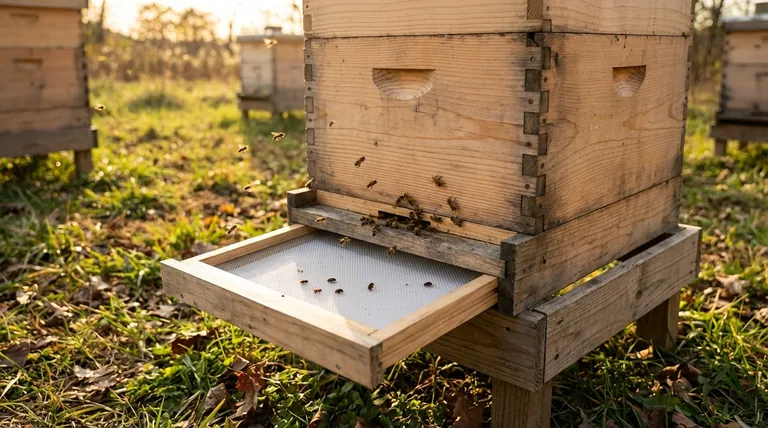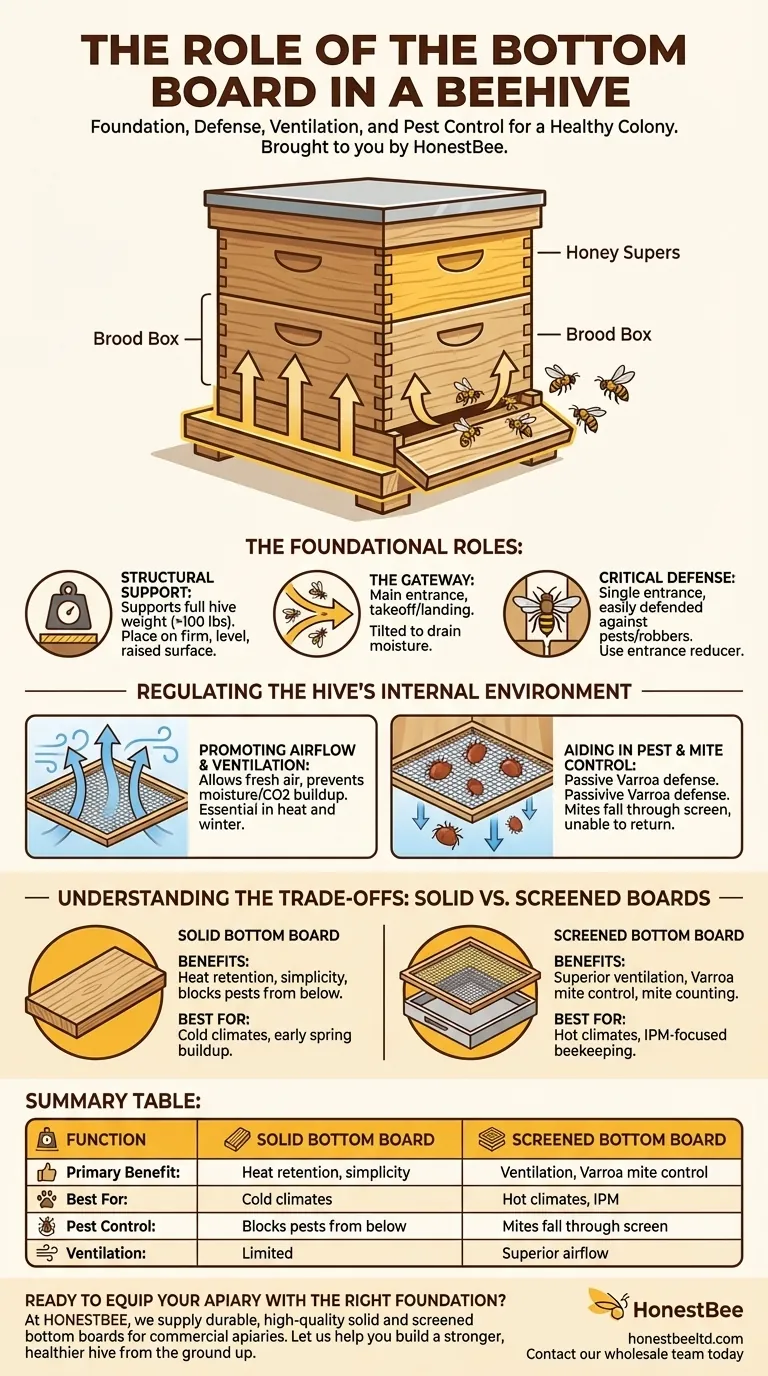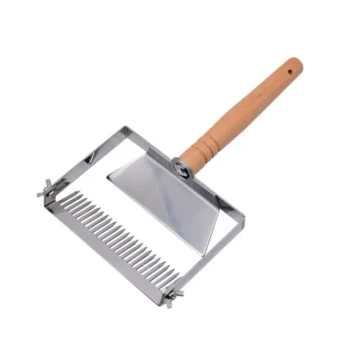At its core, the bottom board is the functional floor and entryway of a beehive. It serves as the foundational base for the entire structure, supports the weight of the colony, and provides a single, defensible entrance for the bees to come and go.
The bottom board is far more than just the hive's floor. It is a critical piece of equipment that directly influences the colony's defense, ventilation, moisture control, and management of pests like Varroa mites. Your choice of bottom board is a strategic decision that impacts the overall health of your hive.

The Foundational Roles of the Bottom Board
Before diving into advanced strategies, it's essential to understand the bottom board's primary, non-negotiable functions.
Structural Support and Stability
The bottom board is the base plate upon which all other hive components—brood boxes, honey supers, and covers—are stacked. It must support the full weight of a thriving colony, which can easily exceed 100 pounds (45 kg).
For this reason, it should be placed on a firm, level surface and raised off the ground to protect the wood from moisture and rot.
The Gateway to the Colony
The bottom board creates the hive's main entrance, serving as the takeoff and landing platform for all foraging bees. Its design funnels traffic through a single, observable point.
A slight forward tilt of the entire hive is crucial. This ensures that any rainwater hitting the landing area drains away from the hive interior, preventing moisture buildup.
A Critical Point of Defense
A single, well-defined entrance is much easier for guard bees to defend against robbers from other colonies or pests like wasps and mice.
For smaller or newly established colonies, an entrance reducer is used. This is a small block of wood that narrows the opening, reducing the area the guards must patrol and protecting the vulnerable colony from being overwhelmed.
Regulating the Hive's Internal Environment
Beyond its structural role, the bottom board is an active tool for managing the delicate internal environment that bees require to thrive.
Promoting Airflow and Ventilation
Proper ventilation is essential to prevent the buildup of excess moisture and carbon dioxide. The bottom board, particularly a screened variant, plays a significant role in allowing fresh air to circulate from below.
This is especially important during hot weather to help bees cool the hive and during winter to prevent condensation from dripping onto the cluster.
Aiding in Pest and Mite Control
The bottom board is a beekeeper's first line of defense and diagnosis for Varroa mites, one of the most significant threats to honey bees.
This is where the distinction between the two main types of bottom boards becomes critical.
Understanding the Trade-offs: Solid vs. Screened Boards
Your choice of bottom board is not arbitrary. Each type offers distinct advantages and is suited to different climates and management styles.
The Case for Solid Bottom Boards
A solid bottom board is a simple, solid piece of wood. It is traditionally common and offers excellent durability.
Its main benefits are lower cost and potentially better heat retention. Some beekeepers believe this helps the colony build up its population more quickly in the early spring. It also completely blocks pests from entering from underneath the hive.
The Advantages of Screened Bottom Boards
A screened bottom board (or "Integrated Pest Management" board) features a durable wire screen floor, often with a removable solid tray underneath.
Its primary advantage is superior ventilation, which helps reduce heat stress in summer. More importantly, it helps control Varroa mites; as mites naturally fall off bees, many will drop through the screen and out of the hive, unable to return. The removable tray allows a beekeeper to perform a "mite count" to assess the level of infestation.
Making the Right Choice for Your Hive
Selecting a bottom board depends on your local climate, management goals, and philosophy on pest control.
- If your primary focus is simplicity and cold climate performance: A solid bottom board may help conserve heat and encourage a slightly earlier spring brood buildup.
- If your primary focus is pest management and hot climate ventilation: A screened bottom board is the superior choice for passive Varroa mite control and preventing hive overheating.
- If you are a new beekeeper seeking flexibility and data: Start with a screened bottom board, as it provides crucial information on mite levels and is more forgiving in hot weather.
Ultimately, understanding the bottom board transforms it from a simple piece of wood into a powerful tool for ensuring your colony's long-term health and success.
Summary Table:
| Function | Solid Bottom Board | Screened Bottom Board |
|---|---|---|
| Primary Benefit | Heat retention, simplicity | Ventilation, Varroa mite control |
| Best For | Cold climates, early spring buildup | Hot climates, IPM-focused beekeeping |
| Pest Control | Blocks pests from below | Allows mites to fall through screen |
| Ventilation | Limited | Superior airflow |
Ready to equip your apiary with the right foundation?
At HONESTBEE, we understand that the bottom board is a critical piece of beekeeping equipment that directly impacts your colony's defense, ventilation, and pest management. We supply durable, high-quality solid and screened bottom boards designed for the needs of commercial apiaries and beekeeping equipment distributors.
Let us help you build a stronger, healthier hive from the ground up.
Contact our wholesale team today to discuss your needs and get a quote on our full range of beekeeping supplies and equipment.
Visual Guide

Related Products
- Langstroth Screen Bottom Board for Beekeeping Wholesale
- Australian Pine Wood Langstroth Screen Bottom Board for Wholesale
- HONESTBEE Wooden Bee Escape Board with Triangle Mesh Design for Beekeeping
- Boardman Entrance Bee Feeder Durable Galvanized Steel and Wood Construction for Beekeeping
- Professional Galvanized Hive Strap with Secure Locking Buckle for Beekeeping
People Also Ask
- What are some considerations when choosing between solid and screened bottom boards? Optimize Hive Health & Pest Control
- What are the advantages of a screened bottom board? Boost Hive Health with Superior Ventilation & Pest Control
- What are the benefits of using a screened bottom board in warm or humid climates? Boost Hive Health & Control Pests
- What is the primary function of a screened bottom board in a hive? Enhance Ventilation & Control Varroa Mites
- What are the assembly options for the Cypress Screened Bottom Board? Ready-to-Use for Immediate Hive Health



















